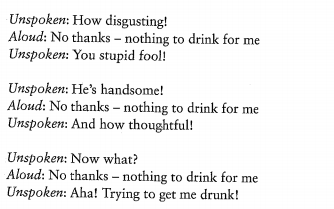Q.1 At the end of the semester, I would like to be able to develop critical thinking skills and learn how to recognize film making techniques by deconstructing films and clips. Also, to understand how documentaries are made, what are the similarities and differences between non fiction and fiction film. Learning the fundamentals of film language, how to shoot an interview, formulating questions that will make a good interview, and be more expose to film editing programmes other than Final Cut Pro. I would want to be able to use Adobe premium like a pro!
Q2. I’ve always wondered what was the reason why courier fonts were used in screen plays. I’ve always thought it was just something that was old and nostalgic that people thought were cool before the invention of computers. And how typewriter fonts kinda look “artsy” and classic to me. Then I found out that it wasn’t all about aesthetics but a timing issue and for formmating reasons.. Courier is a fixed-pitch font, meaning each character or space is exactly the same width. Since standard screenplay format is designed so that one page approximately equals one minute of screen time, consistant character spacing is important. One formatted script page in Courier font equals roughly one minute of screen time. Hence the average page count of a screenplay should come in between 90 and 120 pages!!!! NEVER KNEW. Fonts can play such a big part in script writing…
A screenplay can be an original piece, or based on a true story or previously written piece, like a novel, stage play or newspaper article. At its heart, a screenplay is a blueprint for the film it will one day become. Professionals on the set including the producer, director, set designer and actors all translate the screenwriter’s vision using their individual talents. Since the creation of a film is ultimately a collaborative art, the screenwriter must be aware of each person’s role and as such, the script should reflect the writer’s knowledge.
Q.3 With regards to the reading of Week 2’s Slogans for the screenwriter’s wall, Mackendrick mentions about how “an overly concious understanding of the techniques of the film director on the part of the actor may, in some cases, hamper his ability to give a good performance”. He thinks that while knowing too much of how everything works, sometimes can be a downfall when it comes to performing and in return”inhibit the magical process” of acting. Often, too many people think that acting is easy. Just like any art form, acting is a craft and can only be mastered.
In addition, this reading has also taught me that the making of a film is not just about the actor’s ability to do a great scene. So what if you take acting classes, and you take time to hone your craft, not knowing how to react to being infront of the camera can be a bummer. Filming a show involves much more than that : timing, making the cut to a point of view precisely on the frame, subtle facial expressions and more actions rather than dialogue. These are things that has to be worked out with the directors and the actors themselves.
Mastering the spoken word vs sense of conscious control:
He talks about how the best screen actors are those who not only give attention to words, but have a clear understanding of the subtext of the scene at hand, the unwritten words, feelings and thoughts that serves as preparation of the dialogue. Having the actors to decide and write a continuous inner soliloquy that expresses thoughts, emotions and attitudes. Knowing how to master these, comes a great length when it comes to controlling the inflection of words, the length of silences and gestures.
